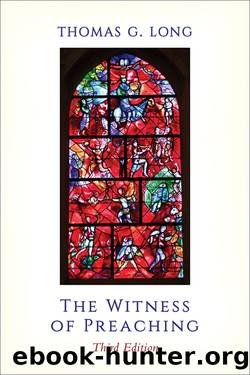The Witness of Preaching, Third Edition by Long Thomas G

Author:Long, Thomas G. [Long, Thomas G.]
Language: eng
Format: epub
Publisher: Westminster John Knox Press
Published: 2016-10-09T16:00:00+00:00
Both of these sermon forms employ the same set of Moves, but each displays a different order. The first preacher decided to use a fairly straightforward “problem-response” form. The problem is named, false responses are cleared out, and then it is on to the Romans text for a deeper response. The second preacher, however, decided to take a somewhat different approach and, therefore, to craft a different form. This preacher chose to start not with the problem itself but with some of the false comforters in the culture that offer sentimental greeting-card responses to human suffering. Next, experiences of real human suffering are brought forward to show how superficial these sentiments are, and then the preacher turns to the text for a deeper answer. So if the first preacher crafted a “problem/response” form, this second preacher created a “here-is-the-prevailing-cultural-view/here-is-the-word-of-the-gospel” form. In the first sermon, the gospel responds to an aching question that the listeners have; in the second sermon, the gospel argues against a popular cultural attitude.
Both forms are good; both grow out of the sermon’s focus and function. They differ because each preacher discerned that a certain sequence would work best to help the congregation move toward the sermon destination. Deciding which form to employ is a matter of discernment on the part of the preacher. If the sermon is to be an act of Christian proclamation, the hearers must not be passive. They should participate with the preacher in the creation of the event of proclamation, and the preacher should choose the sermon form that best allows the hearers to exercise their ministry of active and creative listening. If the hearers cannot follow the structural movements of the sermon, they will experience it as toil. Recently, when a group of researchers interviewed hearers about what they hear in sermons, many of the hearers complained about sermons that are unfollowable, that do not unfold in some orderly way. One layperson reported the following experience:
There was a time, and it wasn’t very long ago, when we had a guest preacher, and it was absolutely horrible. I’m used to orderly, structured listening, and going somewhere. This person rambled and was everywhere, and I was so exhausted. I was so tired trying to hear, “What are you trying to say?” So that just made me very tired and I thought, “Please don’t bring that person back here anymore.” 24
Good Sermon Form: Two Examples
Another example of good sermon form can be seen in Edmund Steimle’s superb Christmas Eve sermon on Luke 2:1–20, “The Eye of the Storm.” 25 The full text of this sermon can be found in Appendix A .
The focus of this sermon is that the beautiful story of Jesus’ birth in a manger, its “all is calm, all is bright” character, should not lull us into a romantic view of the Christ child disconnected from the conflict, pain, suffering, and violence of Jesus’ life—or ours. The function of the sermon is to replace the sentimental and nostalgic “I’m dreaming of
Download
This site does not store any files on its server. We only index and link to content provided by other sites. Please contact the content providers to delete copyright contents if any and email us, we'll remove relevant links or contents immediately.
Evangelism In a Skeptical World: How to Make the Unbelievable News About Jesus More Believable by Sam Chan(196)
Evangelism Without Additives by Jim Henderson(155)
The Witness of Preaching, Third Edition by Long Thomas G(154)
How to Preach a Dangerous Sermon by Frank A. Thomas(149)
Emotionally Healthy Discipleship by Peter Scazzero(148)
Transforming Fellowship: 19 Brain Skills That Build Joyful Community by Chris M Coursey(145)
The Art of Preaching Old Testament Narrative by Steven D. Mathewson(128)
Sermons of St. Alphonsus: For All the Sundays of the Year by St. Alphonsus Liguori(122)
Contagious Disciple Making: Leading Others on a Journey of Discovery by David Watson & Paul Watson(113)
Smart Sermon: How to Preach Intelligent Biblical Sermons that Transform Lives by Reimar Vetne(108)
Captured Fire: The Sunday Homilies, Cycle B by Krempa S. Joseph(104)
How to Write and Preach a Sermon: Practical Advice for the New Preacher by Christopher Bentliff(104)
Reciprocal Missions: Short-Term Missions that Serve Everyone by Steiner Phil & Schuetze DJ(93)
Christian Missionary Engagement in Central Nigeria, 1857â1891 by Femi J. Kolapo(87)
Determining the Form: Structures for Preaching (Elements of Preaching) by O. Wesley Allen(87)
Preaching Better by Ken Untener(86)
Outreach and Renewal by McSherry James(84)
Recovered by Robby Gallaty & Rob Suggs & David Platt(73)
